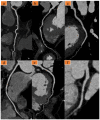Dedicated CCTA Followed by High-Pitch Scanning versus TRO-CT for Contrast Media and Radiation Dose Reduction: A Retrospective Study
- PMID: 36359488
- PMCID: PMC9688948
- DOI: 10.3390/diagnostics12112647
Dedicated CCTA Followed by High-Pitch Scanning versus TRO-CT for Contrast Media and Radiation Dose Reduction: A Retrospective Study
Abstract
We aimed to compare dedicated coronary computed tomography angiography (CCTA) followed by high-pitch scanning and triple-rule-out computed tomography angiography (TRO-CTA) in terms of radiation dose, contrast media (CM) use, and image quality. Patients with acute chest pain were retrospectively enrolled and assigned to group A (n = 55; scanned with dedicated CCTA followed by high-pitch scanning) or group B (n = 45; with TRO-CTA). Patient characteristics, radiation dose, CM use, and quantitative parameters (CT value, image noise, signal-to-noise ratio, contrast-to-noise ratio, and image quality score) of pulmonary arteries (PAs), thoracic aortae (TAs), and coronary arteries (CAs) were compared. The total effective dose was significantly lower in group A (6.25 ± 2.94 mSv) than B (8.93 ± 4.08 mSv; p < 0.001). CM volume was significantly lower in group A (75.7 ± 8.9 mL) than B (95.0 ± 0 mL; p < 0.001). PA and TA image quality were significantly better in group B, whereas that of CA was significantly better in group A. Qualitative image scores of PA and TA scans rated by radiologists were similar, whereas that of CA scans was significantly higher in group A than B (p < 0.001). Dedicated CCTA followed by high-pitch scanning demonstrated lower radiation doses and CM volume without debasing qualities of PA, TA, and CA scans than did TRO-CTA.
Keywords: contrast media; coronary CT angiography; high-pitch scanning; image quality; radiation dose.
Conflict of interest statement
The authors declare no conflict of interest.
Figures



Similar articles
-
Optimizing acute chest pain diagnosis: Efficacy of 64-channel multi-slice CT with Snap-Shot Freeze technique in Triple-Rule-out CT angiography.Heliyon. 2024 Nov 22;10(23):e40642. doi: 10.1016/j.heliyon.2024.e40642. eCollection 2024 Dec 15. Heliyon. 2024. PMID: 39669141 Free PMC article.
-
Comparison of image quality and arterial enhancement with a dedicated coronary CTA protocol versus a triple rule-out coronary CTA protocol.Acad Radiol. 2009 Sep;16(9):1039-48. doi: 10.1016/j.acra.2009.03.013. Epub 2009 Jun 11. Acad Radiol. 2009. PMID: 19523852
-
Triple-rule-out CT angiography using two axial scans with 16 cm wide-detector for radiation dose reduction.Eur Radiol. 2018 Nov;28(11):4654-4661. doi: 10.1007/s00330-018-5426-y. Epub 2018 May 22. Eur Radiol. 2018. PMID: 29789908 Clinical Trial.
-
Triple Rule Out Versus Coronary CT Angiography in Patients With Acute Chest Pain: Results From the ACIC Consortium.JACC Cardiovasc Imaging. 2015 Jul;8(7):817-25. doi: 10.1016/j.jcmg.2015.02.023. Epub 2015 Jun 17. JACC Cardiovasc Imaging. 2015. PMID: 26093928
-
Triple-rule-out CT angiography for evaluation of acute chest pain and possible acute coronary syndrome.Radiology. 2009 Aug;252(2):332-45. doi: 10.1148/radiol.2522082335. Radiology. 2009. PMID: 19703877 Review.
Cited by
-
Comparing Different Contrast Injection Methods for Multislice Spiral CT Imaging in Triple-Rule-Out Examinations: A Study on Acute Chest Pain Patients.Int J Gen Med. 2025 Mar 5;18:1231-1246. doi: 10.2147/IJGM.S496454. eCollection 2025. Int J Gen Med. 2025. PMID: 40065978 Free PMC article.
-
Optimizing acute chest pain diagnosis: Efficacy of 64-channel multi-slice CT with Snap-Shot Freeze technique in Triple-Rule-out CT angiography.Heliyon. 2024 Nov 22;10(23):e40642. doi: 10.1016/j.heliyon.2024.e40642. eCollection 2024 Dec 15. Heliyon. 2024. PMID: 39669141 Free PMC article.
-
Low KV-low contrast medium dose one-stop dual source CT high pitch integrated coronary-carotid-cerebral-aortic CTA improves image quality and reduces both radiation and contrast medium doses.Eur J Radiol Open. 2025 Jan 29;14:100637. doi: 10.1016/j.ejro.2025.100637. eCollection 2025 Jun. Eur J Radiol Open. 2025. PMID: 39944781 Free PMC article.
References
-
- Chae M.K., Kim E.K., Jung K.Y., Shin T.G., Sim M.S., Jo I.J., Song K.J., Chang S.A., Song Y.B., Hahn J.Y., et al. Triple rule-out computed tomography for risk stratification of patients with acute chest pain. J. Cardiovasc. Comput. Tomogr. 2016;10:291–300. doi: 10.1016/j.jcct.2016.06.002. - DOI - PubMed
LinkOut - more resources
Full Text Sources

